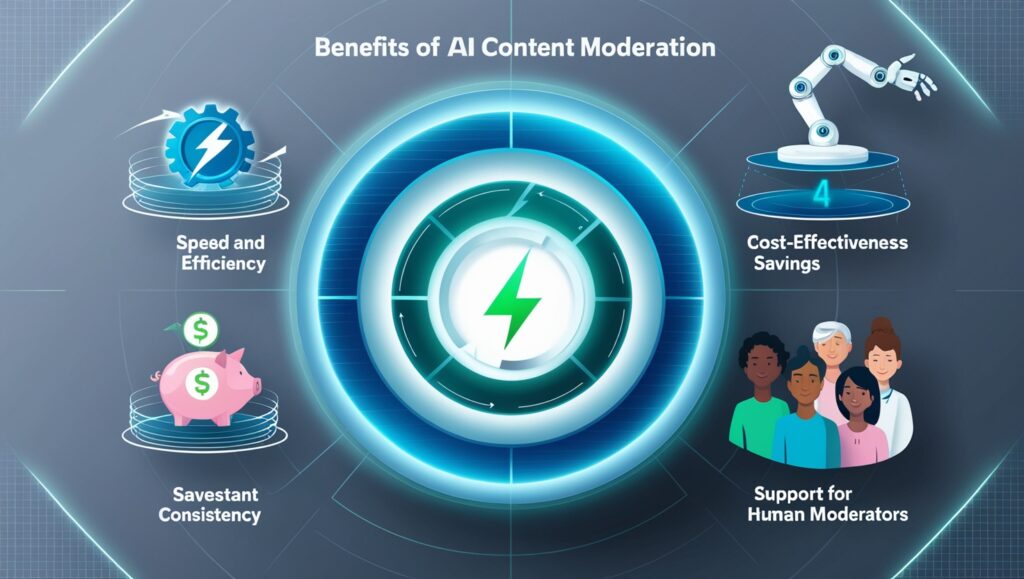AI in Content Moderation: Ensuring Safer Online Communities
Introduction
As the internet continues to grow, so does the volume of user-generated content (UGC) on platforms like social media, forums, e-commerce sites, and more. With billions of posts, comments, videos, and images shared daily, maintaining a safe and respectful online environment is a monumental challenge. Enter Artificial Intelligence (AI), a transformative force in content moderation. AI is helping platforms detect, analyze, and manage harmful or inappropriate content with greater speed and efficiency. This blog explores how AI is revolutionizing content moderation, the tools and technologies involved, and the ethical and technical challenges it presents.

What is Content Moderation?
Content moderation involves monitoring and managing UGC to ensure it adheres to community guidelines and legal requirements. This includes identifying and removing:
- Hate speech and abusive language.
- Explicit or inappropriate images and videos.
- Misinformation and fake news.
- Spam and scams.
While traditional moderation relies heavily on human reviewers, AI-powered systems are increasingly being integrated to enhance scalability and accuracy.
How AI is Transforming Content Moderation
1. Automated Content Detection
AI tools use machine learning (ML) models and natural language processing (NLP) to analyze text, images, and videos. These systems can:
- Flag explicit language, hate speech, or harmful content in real time.
- Identify and blur explicit images before human review.
- Detect deepfake videos and manipulated media.
For example, platforms like Facebook and YouTube use AI to automatically detect and remove content that violates their guidelines.
2. Real-Time Moderation
AI operates at incredible speed, enabling real-time moderation. This is particularly crucial for live-streamed content, where harmful material must be flagged or removed instantly to prevent widespread dissemination.
3. Improved Scalability
AI systems can process vast amounts of content far beyond human capacity, making them ideal for platforms with millions of daily active users. This scalability is critical for global platforms like Twitter, TikTok, and Reddit.
4. Contextual Analysis
Advanced AI models can analyze context to differentiate between harmful content and benign material. For example:
- Understanding sarcasm or jokes to avoid false positives.
- Recognizing cultural nuances and regional dialects.
AI Tools for Content Moderation
1. Text Moderation
- Perspective API: Developed by Jigsaw, this tool detects toxic language in comments and provides a toxicity score.
- Azure Content Moderator: Offers text analysis to identify profanity, hate speech, and spam.
2. Image and Video Moderation
- Google Cloud Vision AI: Detects explicit or inappropriate content in images.
- Hive Moderation: Specializes in identifying harmful content in both images and videos, including violence and nudity.
3. Audio Moderation
- Descript: Analyzes and transcribes audio files to detect offensive language.
- Speechmatics: Transcribes and flags harmful content in spoken language.
Benefits of AI in Content Moderation

1. Speed and Efficiency
AI processes content faster than human moderators, enabling platforms to address harmful material in real time.
2. Cost-Effectiveness
While initial implementation can be costly, AI reduces the need for extensive human moderation teams, lowering long-term operational costs.
3. Consistency
AI applies rules uniformly, eliminating subjective biases that human moderators might introduce.
4. Support for Human Moderators
AI doesn’t replace human moderators but complements them by handling routine tasks, allowing human reviewers to focus on nuanced cases.
Challenges of AI in Content Moderation
1. False Positives and Negatives
AI models are not perfect and may:
- Flag harmless content as harmful (false positives).
- Miss subtle harmful content (false negatives).
2. Contextual Understanding
Despite advancements, AI struggles with understanding sarcasm, humor, or regional cultural contexts, leading to moderation errors.
3. Bias in AI Models
AI systems can inherit biases from their training data, leading to unfair moderation practices. For example, certain groups may experience disproportionate content removals.
4. Ethical Concerns
Over-reliance on AI raises ethical questions, including:
- Freedom of expression and censorship.
- Privacy concerns during content analysis.
Case Studies: AI in Action
1. Facebook
Facebook uses AI to moderate millions of posts daily, detecting hate speech, misinformation, and graphic content. Its AI systems reportedly remove over 95% of harmful content before user reporting.
2. YouTube
YouTube’s AI systems remove videos that violate community guidelines within minutes of being uploaded. This includes violent extremism, misinformation, and copyright violations.
3. Reddit
Reddit employs AI to identify and remove spam, offensive comments, and abusive behavior in its vast network of communities.
The Future of AI in Content Moderation
As AI technology advances, its role in content moderation will expand. Future developments may include:
- Emotion Detection: AI could analyze emotional tone to better understand intent behind content.
- Multimodal Analysis: Combining text, image, and audio analysis for comprehensive moderation.
- Adaptive Learning: AI models that continuously learn from moderator feedback and adapt to new challenges.
- Ethical AI Frameworks: Development of standards to address biases and ensure fairness.
Conclusion
AI has become an indispensable tool in content moderation, offering speed, scalability, and efficiency. While challenges like contextual understanding and ethical concerns remain, advancements in AI technology promise to address these issues. The key lies in balancing AI capabilities with human oversight, ensuring that online communities are not only safe but also respectful and inclusive.
As platforms continue to grow, leveraging AI effectively will be critical in creating healthier digital ecosystems for all.









